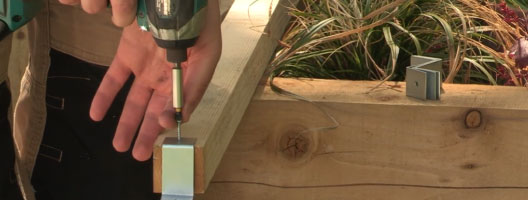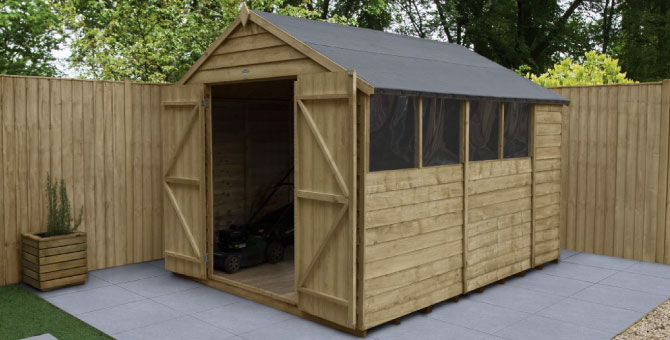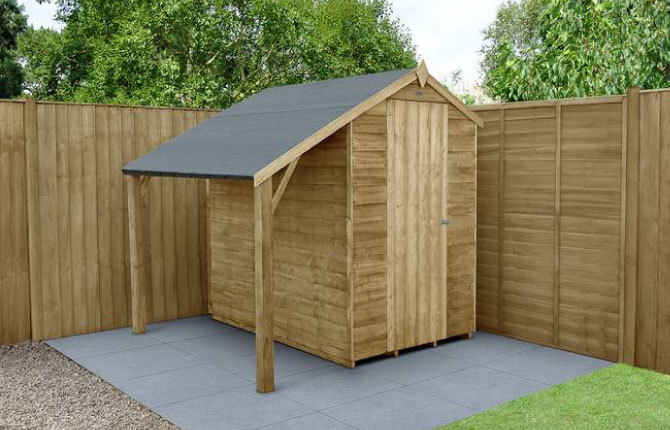Choosing the right size for your new garden shed usually comes down to two key factors, how much space you have in your garden and what you want to store in the shed once it's installed.
Needless to say, if you have a smaller garden, then you will want to focus your search on a smaller shed, but if you've got space to spare then you have more options. Measure out the area that you want to allocate to your new shed, and use those measurements as your starting point. Sheds come in all shapes and sizes, so chances are that you'll easily find something that fits your space.
Just as important as the space that you have in the garden, is the space that you need in the shed. If you are buying a shed to store bikes in, then it needs to be big enough for that. Make a plan of what you want to put in the shed, and go from there. If space is a premium, remember you can always get a taller shed and install shelving!
 4x3, 5x3 or 6x3 – small and compact. Perfect for neatly storing garden tools or bikes but it will be a squeeze if you need to store larger items
4x3, 5x3 or 6x3 – small and compact. Perfect for neatly storing garden tools or bikes but it will be a squeeze if you need to store larger items
 6x4, 7x5, 7x7, 8x6 or 8x8 – the mid-size choice. Suitable for larger equipment like lawnmowers and bikes
6x4, 7x5, 7x7, 8x6 or 8x8 – the mid-size choice. Suitable for larger equipment like lawnmowers and bikes
 10x6, 10x8, 10x10, 12x8, 15x10, 20x10 – large and spacious. Offers more storage space or big enough to be used as a workshop
10x6, 10x8, 10x10, 12x8, 15x10, 20x10 – large and spacious. Offers more storage space or big enough to be used as a workshop
Just as with size, the style of shed that you choose will be determined by external factors like the space available and the purpose of the shed. If you want to squeeze the shed into a tight corner, then perhaps a corner shed would be best.
But there is also room for a bit of personal preference as well. Don't forget to choose a shed that you like the look of, after all, you'll be the one living with it! And if you've invested time and effort making your garden a relaxing and luxurious space, make sure that you choose a style that fits well with the rest of the garden.

Apex – Useful if the shed will be used to store tall items. Water will run off easily when it rains

Pent – A good choice if height needs to be restricted for any reason. Guttering that leads to a water butt can be added too

Reverse apex – Similar to an apex style but the door is on the longer side of the shed, another option to consider depending on the space available

Corner – If a shed will be placed into a corner this style makes sense. Can also be used to hide an area of a back garden
3. Choose the construction
Choosing the right construction style takes a little bit more thought, so it makes sense to think of it next after selecting the size and style.
First to consider is budget, as different construction types tend to result in a different in price. A shiplap tongue and groove shed will likely cost more than an overlap shed of equal size and style. However that shiplap shed will be more durable, last longer, and will offer better protection to whatever you store inside. If you're confident that you'll want your new shed to last a a couple of decades in an exposed location, then it might be worth investing in the pricier option, but if a house move is on the cards in the next 5 years then maybe you should go for something cheaper.
 Overlap – Rough-sawn boards overlap to ensure water run-off
Overlap – Rough-sawn boards overlap to ensure water run-off
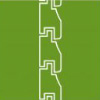 Shiplap tongue and groove – A more robust set up with interlocking tongue and groove boards with a shiplap profile for water run-off
Shiplap tongue and groove – A more robust set up with interlocking tongue and groove boards with a shiplap profile for water run-off
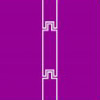 Tongue and groove – Very tough. Tight tongue and groove boards for wind and rain protection
Tongue and groove – Very tough. Tight tongue and groove boards for wind and rain protection
Choosing the treatment is a little like choosing the construction type, as different treatments normally mean different reactions to being outside in the Great British weather. If you want your shed to last as long as possible, and are investing in something on the more expensive side of things, you might want to protect your purchase with a more comprehensive treatment.
Forest offers two types of treatment:
- Dip treated – the shed boards are dipped in anti-fungal solution at the factory. A surface-level treatment that provides short term protection against rot. 10-year anti-rot guarantee provided
- Pressure treated – anti-fungal preservative is forced into the timber under pressure. 15-year anti-rot guarantee provided
The final factor to consider is what base to put your shed on top of. Choosing the right base is important for ensuring the stability and durability of your shed, as well as maximising how it performs the task that you've bought it for.
A key consideration is the terrain that you plan to place the shed on. A timber base works best if you're on a bit of a hill, whereas a solid concrete base which will need excavating and levelling the land will be more work. However, if you're planning on using your shed to store heavy items, a concrete or slab base would be preferred.
One thing is certain, to get the most out of your shed you will need a base. No base might mean that you shed is unstable and unsafe, and won't allow water to run away which may mean that it starts to rot very quickly.
Forest recommends a base for the new shed is prepared one of three ways:

Concrete slabs – these are laid neatly with minimal gaps, on top of a dressing of sharp sand and hardcore

Concrete – a solid concrete base will minimise movement of sub-soil, so there’s much less chance your shed will move or drop over time

Timber base – this would be made of a timber frame that’s attached to stakes driven into the ground. Can be a useful solution if concrete or concrete slabs can’t be used


 4x3, 5x3 or 6x3 – small and compact. Perfect for neatly storing garden tools or bikes but it will be a squeeze if you need to store larger items
4x3, 5x3 or 6x3 – small and compact. Perfect for neatly storing garden tools or bikes but it will be a squeeze if you need to store larger items 6x4, 7x5, 7x7, 8x6 or 8x8 – the mid-size choice. Suitable for larger equipment like lawnmowers and bikes
6x4, 7x5, 7x7, 8x6 or 8x8 – the mid-size choice. Suitable for larger equipment like lawnmowers and bikes 10x6, 10x8, 10x10, 12x8, 15x10, 20x10 – large and spacious. Offers more storage space or big enough to be used as a workshop
10x6, 10x8, 10x10, 12x8, 15x10, 20x10 – large and spacious. Offers more storage space or big enough to be used as a workshop Overlap – Rough-sawn boards overlap to ensure water run-off
Overlap – Rough-sawn boards overlap to ensure water run-off Shiplap tongue and groove – A more robust set up with interlocking tongue and groove boards with a shiplap profile for water run-off
Shiplap tongue and groove – A more robust set up with interlocking tongue and groove boards with a shiplap profile for water run-off Tongue and groove – Very tough. Tight tongue and groove boards for wind and rain protection
Tongue and groove – Very tough. Tight tongue and groove boards for wind and rain protection